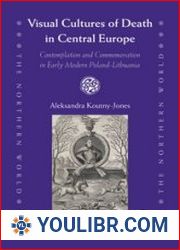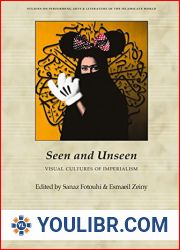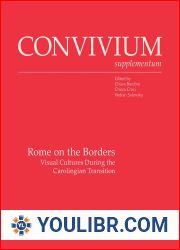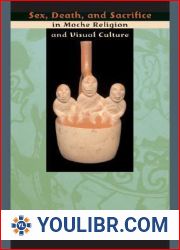
BOOKS - HUMANITIES - Visual Cultures of Death in Central Europe. Contemplation and Co...

Visual Cultures of Death in Central Europe. Contemplation and Commemoration in Early Modern Poland-Lithuania
Author: Aleksandra Koutny-Jones
Year: 2015
Format: PDF
File size: 16.4 MB
Language: ENG

Year: 2015
Format: PDF
File size: 16.4 MB
Language: ENG

Long Description of the Book's Plot: In "Visual Cultures of Death in Central Europe Aleksandra Koutny Jones offers an in-depth exploration of the cultural fixation on death in the PolishLithuanian Commonwealth during the 16th to 18th centuries. Through a comprehensive analysis of various Baroque art forms like coffin portraits, funerary decorations, tomb chapels, and religious landscapes, the author delves into the intricate relationship between mortality and visual representation in early modern PolandLithuania. This period saw an unprecedented rise in the popularity of death-centric art, reflecting the society's deep fascination with the concept of mortality. The book meticulously examines how these visual representations of death served as a means of contemplation and commemoration, providing insight into the beliefs and values of the time. The author begins by discussing the significance of death in PolishLithuanian culture, highlighting the impact of the Protestant Reformation and the CounterReformation on shaping attitudes towards mortality. She then delves into the evolution of funerary art, tracing its development from simple wooden effigies to elaborate stone sculptures and ornate frescoes. These art forms not only reflected the social status of the deceased but also conveyed their spiritual journey towards eternal life.
Длинное описание сюжета книги: В «Визуальных культурах смерти в Центральной Европе» Александра Кутны Джонс предлагает углубленное исследование культурной фиксации смерти в Речи Посполитой в XVI-XVIII веках. Посредством всестороннего анализа различных форм искусства барокко, таких как портреты гробов, погребальные украшения, часовни гробниц и религиозные пейзажи, автор углубляется в сложную взаимосвязь между смертностью и визуальным представлением в ранней современной ПольшеЛитве. В этот период произошел беспрецедентный рост популярности искусства, ориентированного на смерть, что отражает глубокое увлечение общества концепцией смертности. В книге тщательно рассматривается, как эти визуальные представления о смерти служили средством созерцания и поминовения, предоставляя представление о верованиях и ценностях того времени. Автор начинает с обсуждения значения смерти в польско-литовской культуре, подчеркивая влияние протестантской Реформации и Контрреформации на формирование отношения к смертности. Затем она углубляется в эволюцию погребального искусства, прослеживая его развитие от простых деревянных чучел до сложных каменных скульптур и витиеватых фресок. Эти формы искусства не только отражали социальный статус покойного, но и передавали его духовное путешествие к вечной жизни.
Description longue de l'histoire du livre : Dans « Cultures visuelles de la mort en Europe centrale », Alexander Kutna Jones propose une étude approfondie de la fixation culturelle de la mort dans le Discours de la Pololite au XVI-XVIII siècle. Grâce à une analyse complète des différentes formes d'art baroque, telles que les portraits de cercueils, les décorations funéraires, les chapelles de tombes et les paysages religieux, l'auteur explore la relation complexe entre la mortalité et la représentation visuelle dans la première Pologne moderne. Au cours de cette période, la popularité de l'art axé sur la mort a augmenté sans précédent, reflétant la profonde passion de la société pour le concept de mortalité. livre examine attentivement comment ces visuels de la mort ont servi de moyen de contemplation et de commémoration, donnant une idée des croyances et des valeurs de l'époque. L'auteur commence par discuter de l'importance de la mort dans la culture polonaise-lituanienne, soulignant l'impact de la réforme protestante et de la contre-réforme sur la formation de l'attitude à l'égard de la mortalité. Ensuite, elle s'enfonce dans l'évolution de l'art funéraire, en retraçant son développement, des effigies de bois simples aux sculptures de pierre complexes et aux fresques vitrifiées. Ces formes d'art ne reflétaient pas seulement le statut social du défunt, mais transmettaient aussi son voyage spirituel vers la vie éternelle.
Una larga descripción de la trama del libro: En «Culturas visuales de la muerte en central», Alexandre Kutna Jones ofrece un estudio en profundidad de la fijación cultural de la muerte en la Mancomunidad en los siglos XVI-XVIII. A través de un análisis exhaustivo de las diferentes formas de arte barroco, como retratos de ataúdes, decoraciones funerarias, capillas de tumbas y paisajes religiosos, el autor profundiza en la compleja relación entre la mortalidad y la representación visual en la Polonia moderna primitivaLituania. Durante este período se produjo un aumento sin precedentes en la popularidad del arte centrado en la muerte, lo que refleja la profunda fascinación de la sociedad por el concepto de mortalidad. libro examina cuidadosamente cómo estas representaciones visuales de la muerte sirvieron como un medio de contemplación y conmemoración, proporcionando una idea de las creencias y valores de la época. autor comienza discutiendo el significado de la muerte en la cultura polaco-lituana, destacando la influencia de la Reforma Protestante y la Contrarreforma en la formación de actitudes hacia la mortalidad. A continuación se profundiza en la evolución del arte funerario, trazando su desarrollo desde simples efigies de madera hasta complejas esculturas de piedra y frescos ornamentados. Estas formas de arte no sólo reflejaban el estatus social del difunto, sino que también transmitían su viaje espiritual a la vida eterna.
Longa descrição da história do livro: Em «As culturas visuais da morte na Central», Alexander Kutna Jones propõe uma pesquisa aprofundada sobre a gravação cultural da morte no Discurso do século XVI-XVIII. Através de uma análise completa de várias formas de arte barroca, tais como retratos de caixões, adornos funerários, capelas de túmulos e paisagens religiosas, o autor aprofundou-se na complexa relação entre a mortalidade e a representação visual no início contemporâneo da Lituânia. Neste período, houve um aumento sem precedentes na popularidade das artes orientadas para a morte, refletindo o profundo fascínio da sociedade pelo conceito de mortalidade. O livro trata cuidadosamente como essas percepções visuais da morte serviram como meio de contemplação e homenagem, fornecendo uma visão das crenças e valores da época. O autor começa por discutir a importância da morte na cultura polaco-lituana, enfatizando o impacto da Reforma Protestante e da Contrarrelógio na formação de atitudes em relação à mortalidade. Depois, aprofundou-se na evolução da arte funerária, traçando o seu desenvolvimento desde simples empalhados de madeira até complexas esculturas de pedra e murais de vidro. Estas formas de arte não apenas refletiam o status social do falecido, mas também transmitiram sua jornada espiritual para a vida eterna.
Una lunga descrizione della trama del libro: « culture visive della morte in centrale» di Alexander Kutna Jones offre una ricerca approfondita sulla fissazione culturale della morte nel Discorso del XVI-XVIII secolo. Attraverso un'analisi completa di diverse forme d'arte barocca, come ritratti di bare, decorazioni funerarie, cappelle di tombe e paesaggi religiosi, l'autore approfondisce la complessa relazione tra mortalità e rappresentazione visiva nella prima Lituania moderna. In questo periodo c'è stato un aumento senza precedenti della popolarità dell'arte orientata alla morte, che riflette la profonda passione della società per il concetto di mortalità. Il libro considera attentamente come questi concetti visivi della morte siano stati un mezzo di contemplazione e di commemorazione, fornendo un'idea delle credenze e dei valori dell'epoca. L'autore inizia discutendo il significato della morte nella cultura polacco-lituana, sottolineando l'impatto della Riforma protestante e della Controreplicazione sulla formazione del rapporto con la mortalità. Poi si approfondisce nell'evoluzione dell'arte funebre, tracciando il suo sviluppo da semplici impacchi in legno a complesse sculture in pietra e affreschi in vetrata. Queste forme d'arte non solo riflettevano lo status sociale del defunto, ma trasmettevano il suo viaggio spirituale alla vita eterna.
Lange Beschreibung der Handlung des Buches: In „Visuelle Kulturen des Todes in Mitteleuropa“ bietet Alexander Kutny Jones eine eingehende Untersuchung der kulturellen Fixierung des Todes im Rzeczpospolita im 16. bis 18. Jahrhundert. Durch eine umfassende Analyse verschiedener barocker Kunstformen wie Sargporträts, Grabschmuck, Grabkapellen und religiöse Landschaften vertieft sich die Autorin in das komplexe Verhältnis von Sterblichkeit und visueller Repräsentation im frühneuzeitlichen PolenLitauen. In dieser Zeit kam es zu einem beispiellosen Anstieg der Popularität der auf den Tod ausgerichteten Kunst, was die tiefe Faszination der Gesellschaft für das Konzept der Sterblichkeit widerspiegelt. Das Buch untersucht sorgfältig, wie diese visuellen Darstellungen des Todes als Mittel der Kontemplation und des Gedenkens dienten und einen Einblick in die Überzeugungen und Werte der Zeit gaben. Der Autor beginnt mit einer Diskussion über die Bedeutung des Todes in der polnisch-litauischen Kultur und betont den Einfluss der protestantischen Reformation und der Gegenreformation auf die Bildung einer Einstellung zur Sterblichkeit. Dann taucht sie in die Entwicklung der Grabkunst ein und verfolgt ihre Entwicklung von einfachen Holzbildnissen zu komplexen Steinskulpturen und verzierten Fresken. Diese Kunstformen spiegelten nicht nur den sozialen Status des Verstorbenen wider, sondern vermittelten auch seine spirituelle Reise zum ewigen ben.
Długi opis fabuły książki: W „Wizualnych kulturach śmierci w Europie Środkowej” Aleksandra Kutna Jones oferuje dogłębne studium kulturowej utrwalenia śmierci we Wspólnocie w XVI-XVIII wieku. Poprzez wszechstronną analizę różnych form sztuki barokowej, takich jak portrety grobowe, dekoracje pogrzebowe, kaplice grobowe i pejzaże religijne, autor zagłębia się w złożony związek między śmiertelnością a wizualnym przedstawieniem we wczesnej współczesnej Wielkiej Litwie. W tym okresie nastąpił bezprecedensowy wzrost popularności sztuki zorientowanej na śmierć, odzwierciedlający głęboką fascynację społeczeństwa koncepcją śmiertelności. Książka dokładnie rozważa, jak te wizualne przedstawienia śmierci służyły jako środek kontemplacji i upamiętnienia, zapewniając wgląd w wierzenia i wartości czasu. Autor zaczyna od omówienia znaczenia śmierci w kulturze polsko-litewskiej, podkreślając wpływ reformacji protestanckiej i kontrreformacji na kształtowanie postaw wobec śmiertelności. Następnie zagłębia się w ewolucję sztuki pogrzebowej, śledząc jej rozwój od prostych drewnianych effigies do opracowania kamiennych rzeźb i ozdobnych malowideł. Te formy sztuki nie tylko odzwierciedlały społeczny status zmarłego, ale także przekazywały jego duchową podróż do życia wiecznego.
תיאור ארוך של עלילת הספר: ב- ”Cultures Visual of Death in Central Europe” מאת אלכסנדר קוטנה ג 'ונס מציע מחקר מעמיק של הקיבעון התרבותי של המוות בחבר העמים במאות ה-16-18. באמצעות ניתוח מקיף של צורות שונות של אמנות הבארוק, כגון דיוקנאות קבר, קישוטי לוויה, קפלות קבר ונופים דתיים, מתעמק המחבר בקשר המורכב בין תמותה וייצוג חזותי בליטא המודרנית המוקדמת. תקופה זו ראתה עלייה חסרת תקדים בפופולריות של אמנות מוכוונת מוות, המשקפת את המשיכה העמוקה של החברה למושג התמותה. הספר בוחן בקפידה כיצד ייצוגים ויזואליים אלה של המוות שימשו כאמצעי להרהורים ולהנצחה, וסיפק תובנה על האמונות והערכים של אותה תקופה. המחבר מתחיל בדיונים על משמעות המוות בתרבות הפולנית-ליטאית, ומדגיש את השפעתה של הרפורמציה הפרוטסטנטית ואת התנגדותה לרפורמציה על היווצרות גישות לתמותה. לאחר מכן היא מתעמקת באבולוציה של אמנות הלוויה, ומתחקת אחר התפתחותה מפסלי עץ פשוטים ועד לפסלי אבן משוכללים וציורי קיר מקושטים. אמנות זו לא רק שיקפה את מעמדו החברתי של המנוח, אלא גם העבירה את מסעו הרוחני לחיי ־ נצח.''
Kitabın olay örgüsünün uzun açıklaması: Alexander Kutna Jones'un "Orta Avrupa'da Ölümün Görsel Kültürleri'nde, 16-18. yüzyıllarda Commonwealth'teki ölümün kültürel olarak sabitlenmesi hakkında derinlemesine bir çalışma sunuyor. Barok sanatının mezar portreleri, mezar süslemeleri, mezar şapelleri ve dini manzaralar gibi çeşitli biçimlerinin kapsamlı bir analiziyle yazar, erken modern Polonya ve Litvanya'da ölüm ve görsel temsil arasındaki karmaşık ilişkiyi araştırıyor. Bu dönem, ölüme yönelik sanatın popülaritesinde, toplumun ölüm kavramına olan derin hayranlığını yansıtan benzeri görülmemiş bir artış gördü. Kitap, ölümün bu görsel temsillerinin, zamanın inanç ve değerlerine içgörü sağlayan bir tefekkür ve anma aracı olarak nasıl hizmet ettiğini dikkatle ele alıyor. Yazar, Polonya-Litvanya kültüründe ölümün önemini tartışarak, Protestan Reformasyonu ve Karşı Reformasyonun mortaliteye karşı tutumların oluşumu üzerindeki etkisini vurgulayarak başlar. Daha sonra mezar sanatının evrimine giriyor, basit ahşap heykellerden ayrıntılı taş heykellere ve süslü duvar resimlerine kadar gelişimini izliyor. Bu sanat formları sadece ölen kişinin sosyal statüsünü yansıtmakla kalmamış, aynı zamanda onun ebedi hayata olan ruhsal yolculuğunu da aktarmıştır.
وصف طويل لحبكة الكتاب: في «الثقافات المرئية للموت في أوروبا الوسطى» من تأليف ألكسندر كوتنا جونز يقدم دراسة متعمقة للتركيز الثقافي للموت في الكومنولث في القرنين السادس عشر والثامن عشر. من خلال تحليل شامل لمختلف أشكال الفن الباروكي، مثل صور المقابر والزخارف الجنائزية وكنائس القبور والمناظر الطبيعية الدينية، يتعمق المؤلف في العلاقة المعقدة بين الوفيات والتمثيل البصري في بولندا الحديثة المبكرة. شهدت هذه الفترة ارتفاعًا غير مسبوق في شعبية الفن الموجه نحو الموت، مما يعكس افتتان المجتمع العميق بمفهوم الوفيات. ينظر الكتاب بعناية في كيفية استخدام هذه التمثيلات المرئية للموت كوسيلة للتأمل وإحياء الذكرى، مما يوفر نظرة ثاقبة لمعتقدات وقيم ذلك الوقت. يبدأ المؤلف بمناقشة أهمية الموت في الثقافة البولندية الليتوانية، مع التأكيد على تأثير الإصلاح البروتستانتي والإصلاح المضاد على تكوين المواقف تجاه الوفيات. ثم تتعمق في تطور الفن الجنائزي، وتتبع تطوره من تماثيل خشبية بسيطة إلى منحوتات حجرية متقنة وجداريات مزخرفة. لم تعكس هذه الأشكال الفنية الوضع الاجتماعي للمتوفى فحسب، بل نقلت أيضًا رحلته الروحية إلى الحياة الأبدية.
이 책의 음모에 대한 긴 설명: Alexander Kutna Jones의 "중부 유럽의 죽음의 시각 문화" 에서 16-18 세기 영연방의 문화적 죽음에 대한 심층적 인 연구를 제공합니다. 저자는 무덤 초상화, 장례식 장식, 무덤 예배당 및 종교 경관과 같은 다양한 형태의 바로크 예술에 대한 포괄적 인 분석을 통해 초기 현대 폴란드 리투아니아의 필멸의 시각적 표현과 복잡한 관계를 탐구합니다. 이시기에는 필멸의 개념에 대한 사회의 깊은 매력을 반영하여 죽음 지향 예술의 인기가 전례없이 높아졌습니다. 이 책은 이러한 죽음의 시각적 표현이 어떻게 묵상과 기념의 수단으로 작용하여 당시의 신념과 가치에 대한 통찰력을 제공하는지를 신중하게 고려합니다. 저자는 폴란드-리투아니아 문화에서 죽음의 중요성을 논의하면서 시작하여 사망률에 대한 태도 형성에 대한 개신교 개혁과 반개혁의 영향을 강조합니다. 그녀는 장례식 예술의 진화를 탐구하여 단순한 나무 효과에서 정교한 석조 조각과 화려한 벽화에 이르기까지 발전을 추적합니다. 이 예술 형식은 고인의 사회적 지위를 반영 할뿐만 아니라 그의 영적 여정을 영생으로 전달했습니다.
本のプロットの長い説明:アレクサンダー・クトナ・ジョーンズによる「中央ヨーロッパの死の視覚文化」では、16〜18世紀の連邦における死の文化的固定の詳細な研究を提供しています。墓の肖像画、葬儀の装飾、墓の礼拝堂、宗教的な風景など、バロック美術の様々な形態の包括的な分析を通して、著者は初期のポーランド・リトアニアにおける死亡率と視覚表現の複雑な関係を掘り下げます。この時代は、死の概念に対する社会の深い魅惑を反映して、死を中心とした芸術の人気がかつてないほど高まっていました。これらの死の視覚的表現がどのように熟考と記念の手段となったのかを慎重に考察し、当時の信念と価値観についての洞察を提供している。まず、ポーランド・リトアニア文化における死の意義を論じ、プロテスタント宗教改革と反宗教改革が死亡に対する態度の形成に及ぼす影響を強調した。その後、葬儀芸術の進化を掘り下げ、シンプルな木製の絵画から精巧な石彫や華やかな壁画までその発展をたどる。これらの芸術形態は、故人の社会的地位を反映するだけでなく、永遠の命への精神的な旅を伝えました。
書情的長篇描述:在亞歷山大·庫特納(Alexander Kutna)的《中歐死亡的視覺文化》中,瓊斯對16至18世紀英聯邦對死亡的文化修復進行了深入研究。通過對各種巴洛克藝術形式的全面分析,例如棺材肖像,葬禮裝飾,墓堂和宗教風景,作者深入探討了現代早期波蘭立陶宛死亡率與視覺表現之間的復雜關系。在此期間,以死亡為中心的藝術的普及率空前增長,反映出社會對死亡概念的濃厚熱情。該書仔細研究了這些關於死亡的視覺觀念如何通過提供對當時信仰和價值觀的見解而成為沈思和紀念的手段。作者首先討論了死亡在波蘭-立陶宛文化中的重要性,強調了新教改革和反改革對死亡態度的形成的影響。然後,她深入研究了葬禮藝術的發展,追溯了其從簡單的木雕到復雜的石雕和華麗的壁畫的發展。這些藝術形式不僅反映了死者的社會地位,而且還傳達了他永生的精神旅程。
















































